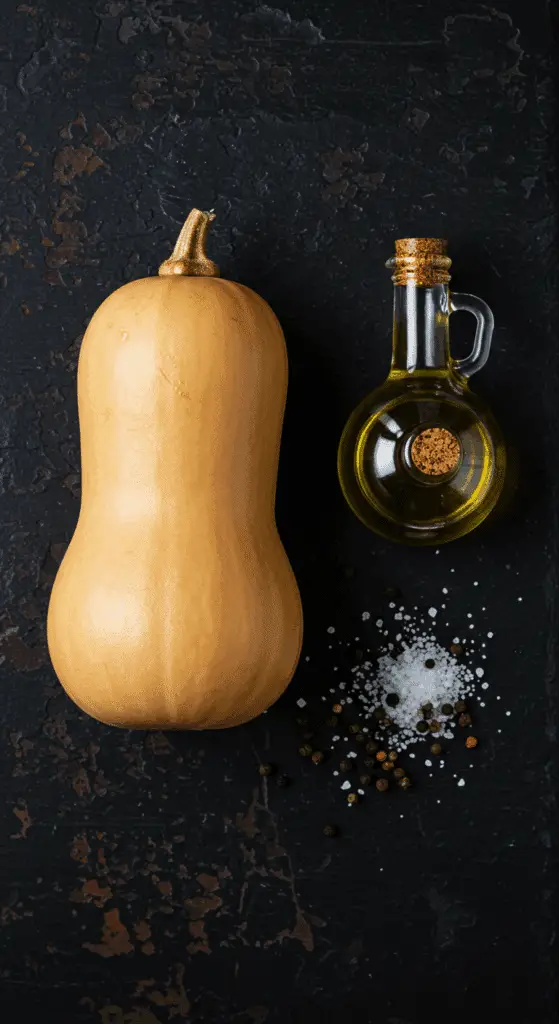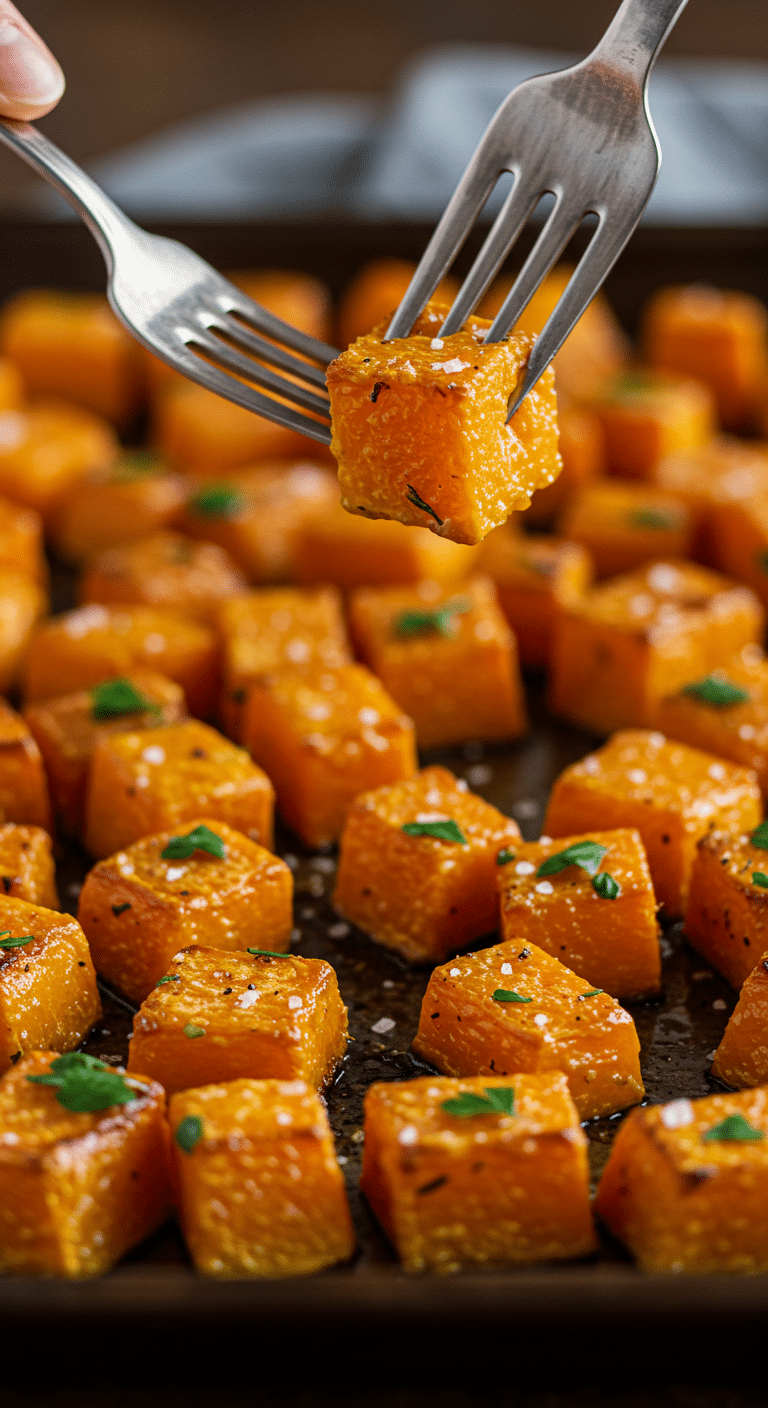Are you ready to learn the one simple, foolproof method that will transform a humble butternut squash into a sweet, caramelized, and utterly irresistible side dish that your whole family will love? The secret is roasting, and this is your ultimate guide to doing it perfectly every single time. Forget steaming or boiling—this is the technique that unlocks the true, delicious potential of this amazing fall vegetable.
This isn’t just a recipe; it’s a complete masterclass in a foundational kitchen skill. We’ll show you everything from the easiest way to peel and cut a notoriously tough butternut squash to the simple secrets of achieving that perfect, deep caramelization in the oven. The result is a versatile, healthy, and incredibly flavorful dish that is perfect as a simple side, a salad topper, or a base for soups and other amazing meals.
Table of Contents
Table of Contents
Recipe Overview: The Ultimate Guide to Perfect Roasting
What makes roasting the absolute best way to cook butternut squash is the magic of high, dry heat. This simple process caramelizes the natural sugars in the squash, creating a deep, sweet, and nutty flavor and beautiful, browned edges that are impossible to achieve through other methods. This recipe is wonderfully minimalist, using just four simple ingredients to let the glorious flavor of the squash shine. It’s a healthy, easy, and endlessly versatile recipe that will become a staple in your cooking repertoire.
| Metric | Time / Level |
| Total Time | 40 minutes |
| Active Prep Time | 10 minutes |
| Difficulty Level | Easy |
| Servings | 4-6 |
The Essential Ingredients for Perfect Roasted Squash
This recipe uses just four simple pantry staples to create a spectacular result.
- Butternut Squash: The sweet, nutty, and vibrant star of the show. You will need one large, 3-pound butternut squash. The key to a delicious result is choosing a good one! Look for a squash that feels heavy for its size, has a solid, even, deep beige color, and is free from any soft spots, cuts, or blemishes.
- Good Olive Oil: A generous coating of a good quality olive oil is essential for helping the squash to brown and caramelize beautifully without drying out. The oil helps to conduct the heat and gives the final dish a lovely, fruity richness.
- Kosher Salt: Seasons the squash and helps to draw out a little bit of moisture, which contributes to better browning.
- Freshly Ground Black Pepper: Adds a final, gentle kick of aromatic spice.
The Ultimate Guide: How to Peel and Cut a Butternut Squash Safely
Tackling a hard, oddly shaped butternut squash can seem intimidating, but this safe and simple method makes it a breeze!
- Trim the Ends: First, use a large, sharp, and heavy chef’s knife to trim off the top stem end and the bottom blossom end of the squash. This will give you two flat, stable surfaces to work with.
- Separate: Stand the squash up on its wider, cut bottom end. Carefully cut the squash in half, right where the long, thin neck meets the round, bulbous bottom part.
- Peel: Now, stand each of the two pieces on one of its flat ends. Use a sturdy Y-shaped vegetable peeler to peel the tough, pale skin away, working in long, confident strips from top to bottom.
- Seed: Cut the round bottom half in two lengthwise. Use a sturdy metal spoon to easily scoop out all the seeds and the stringy bits from the cavity.
- Cube: You can now safely and easily cut the peeled and seeded squash into uniform, 1-inch chunks.

Step-by-Step to Perfectly Caramelized Butternut Squash
Follow these simple, detailed steps for a perfect, tender, and caramelized result every time.
Step 1: Prepare the Squash for Roasting
First, preheat your oven to a hot 400°F (200°C).
Place your 1-inch butternut squash chunks on a large, rimmed baking sheet.
Drizzle the squash with the 3 tablespoons of good olive oil, the 2 teaspoons of kosher salt, and the 1 teaspoon of freshly ground black pepper.
Toss everything together with your hands until every single piece of the squash is evenly and completely coated in the oil and seasonings.
Step 2: Roast to Tender, Caramelized Perfection
Spread the coated squash out in a single, even layer on the baking sheet.
Crucial Pro Tip (The #1 Rule of Roasting!): Do not overcrowd your pan. The squash pieces need space for the hot air to circulate all around them. If they are packed in too tightly, they will steam instead of roast, and they will come out soft and soggy instead of beautifully browned and caramelized. Use two sheet pans if you need to!
Roast for 25 to 30 minutes, tossing the squash with a spatula about halfway through the cooking time to ensure they brown on all sides.
The roasted butternut squash is perfectly done when it is tender all the way through (you can easily pierce a piece with a fork) and has beautiful, deep golden-brown and caramelized edges.
Step 3: Finish and Serve
Take the sweet potatoes out of the oven and transfer them to a serving platter. For a final, rich flourish, you can drizzle them with a little more extra-virgin olive oil.
Serve immediately while they are hot and at their most delicious!

The Perfect Easy Roasted Butternut Squash (A Step-by-Step Guide!)
A simple and basic recipe for classic roasted butternut squash. Cubes of peeled and seeded butternut squash are tossed with a generous amount of good olive oil, kosher salt, and freshly ground black pepper. The seasoned squash is then spread in a single layer on a sheet pan and roasted at a high temperature until it is tender and lightly caramelized.
- Prep Time: 15 minutes
- Cook Time: 28 minutes
- Total Time: 43 minutes
- Yield: 4-6 servings
- Category: Side Dish
- Method: Roasting
- Cuisine: American
- Diet: Vegan
Ingredients
- 1 large butternut squash (about 3 pounds), peeled, seeded, and cut in 1-inch chunks
- 3 tablespoons good olive oil
- 2 teaspoons kosher salt
- 1 teaspoon freshly ground black pepper
Instructions
- Preheat the oven to 400°F.
- Place the butternut squash chunks on a sheet pan.
- Drizzle with the olive oil, and sprinkle with the salt and pepper. Toss well to ensure all the pieces are evenly coated.
- Arrange the squash in a single layer on the pan.
- Roast for 25 to 30 minutes, turning the pieces once with a metal spatula halfway through, until the squash is tender and lightly browned.
- Serve hot.
Notes
- Spreading the squash in a single layer on the baking sheet is a key step to ensure it roasts properly and becomes caramelized, rather than steaming.
- Tossing the squash halfway through the cooking time helps it to brown evenly on all sides.
- This is a versatile basic recipe that can be a side dish on its own, or the roasted squash can be used in salads, soups, or other dishes.
Creative Ways to Use Your Roasted Butternut Squash
While this is a fantastic side dish on its own, it’s also a perfect meal-prep component for a week of healthy meals!
- In a Salad: Let it cool and toss it into a fall salad with arugula, goat cheese, and toasted pecans.
- In a Grain Bowl: Serve it over a bed of warm quinoa or farro with some chickpeas and a drizzle of tahini dressing.
- In a Soup: This is the perfect base for the best butternut squash soup! Simply blend the roasted squash with some warm chicken or vegetable broth until smooth.
- As a Mash: Mash the hot, roasted squash with a little butter and a pinch of sage for a simple and incredibly flavorful mashed squash.
- In Tacos or Quesadillas: Toss the roasted squash with some black beans and use it as a delicious, savory filling for vegetarian tacos or quesadillas.
Storage and Make-Ahead Tips
These roasted butternut squash cubes are a fantastic and healthy staple for meal prepping.
- Make-Ahead: You can peel and cube your raw butternut squash up to 3-4 days in advance. Store the cubes in an airtight container in the refrigerator until you are ready to roast them.
- Storage: Store any leftover roasted butternut squash in an airtight container in the refrigerator for up to 5 days.
- Reheating: The best way to reheat the squash and bring back some of its original texture is in the air fryer or back in a hot 400°F oven. Spread the cubes on a baking sheet and reheat for about 5-10 minutes, until they are hot and the edges have crisped up again.
For more recipe follow my Pinterest account
Creative Recipe Variations
This simple and delicious recipe is a wonderful base for your own creative and flavorful twists.
- Make it Sweet & Spicy: For a delicious, addictive kick of heat that is wonderful with the sweetness of the squash, you can toss the cubes with 1 tablespoon of maple syrup or hot honey and 1/4 to 1/2 teaspoon of cayenne pepper or a smoky chipotle powder along with the salt and pepper before roasting.
- Add a Savory, Herbaceous Twist: For a more classic, Thanksgiving-style flavor, you can toss the squash with 1 tablespoon of fresh, chopped hearty herbs like rosemary, sage, or thyme before you roast it.
- Add Some Warm Spices: For a cozy, fall flavor, you can add 1 teaspoon of a warm spice like cinnamon, smoked paprika, or curry powder to the salt and pepper before you toss the squash.
Enjoy The Perfect, Simple Side Dish!
You’ve just created a truly perfect side dish that is a beautiful harmony of sweet, savory, and nutty flavors. This Easy Roasted Butternut Squash is a testament to how a simple technique can transform a humble ingredient into something truly special and delicious. It’s a versatile and wholesome dish that is sure to become a new staple in your cooking routine.
We hope you enjoy every last, tender, and caramelized bite!
If you enjoyed making this recipe, please leave a comment below or share it with a friend who loves an easy and delicious side dish!
Frequently Asked Questions (FAQs)
Q1: What is the absolute easiest way to peel and cut a butternut squash?
The easiest and safest way is to first trim the top and bottom ends to create flat, stable surfaces. Then, use a sharp chef’s knife to cut the squash in half where the thin neck meets the round bottom. You can now stand each piece on a flat end and safely peel the skin away with a sturdy vegetable peeler. Then, you can easily scoop the seeds out of the bottom half and chop everything into uniform cubes.
Q2: How do I get my roasted butternut squash nicely caramelized and not soggy?
The two most important secrets to crispy, non-soggy roasted vegetables are high heat and not overcrowding the pan. Roasting them at a hot temperature (400°F or higher) is what allows them to caramelize and get crispy, rather than just steaming. Giving them plenty of space on the baking sheet is crucial to allow the hot air to circulate around each piece.
Q3: Can I roast a butternut squash with the skin on? Y
Yes, you can, especially if you are planning to make a puréed soup. The skin of a butternut squash is edible, but it can be quite tough. If you want to eat the roasted squash as cubes, it is much more pleasant to peel it first. To roast it with the skin on, simply cut the squash in half lengthwise, scoop out the seeds, rub it with oil, and roast it cut-side down until tender. Then you can easily scoop the flesh away from the skin.
Q4: Can I make this roasted butternut squash in an air fryer?
Yes, an air fryer is a fantastic tool for making super-caramelized and crispy butternut squash! Simply prepare the squash cubes as directed. Then, place them in your air fryer basket in a single layer (you may need to work in batches). Air fry at about 400°F (200°C) for 15-20 minutes, shaking the basket halfway through, until they are golden, caramelized, and tender.
Q5: How do I choose the best butternut squash at the store? Look f
Q4: Can I make this roasted butternut squash in an air fryer?
Yes, an air fryer is a fantastic tool for making super-caramelized and crispy butternut squash! Simply prepare the squash cubes as directed. Then, place them in your air fryer basket in a single layer (you may need to work in batches). Air fry at about 400°F (200°C) for 15-20 minutes, shaking the basket halfway through, until they are golden, caramelized, and tender.
Q5: How do I choose the best butternut squash at the store?
Look for a squash that has a solid, even, and deep beige color. It should feel firm and heavy for its size, which indicates that it is fresh and has a high moisture content. Avoid any squashes that have deep cuts, bruises, or soft, mushy spots. The stem should also be intact and dry.


